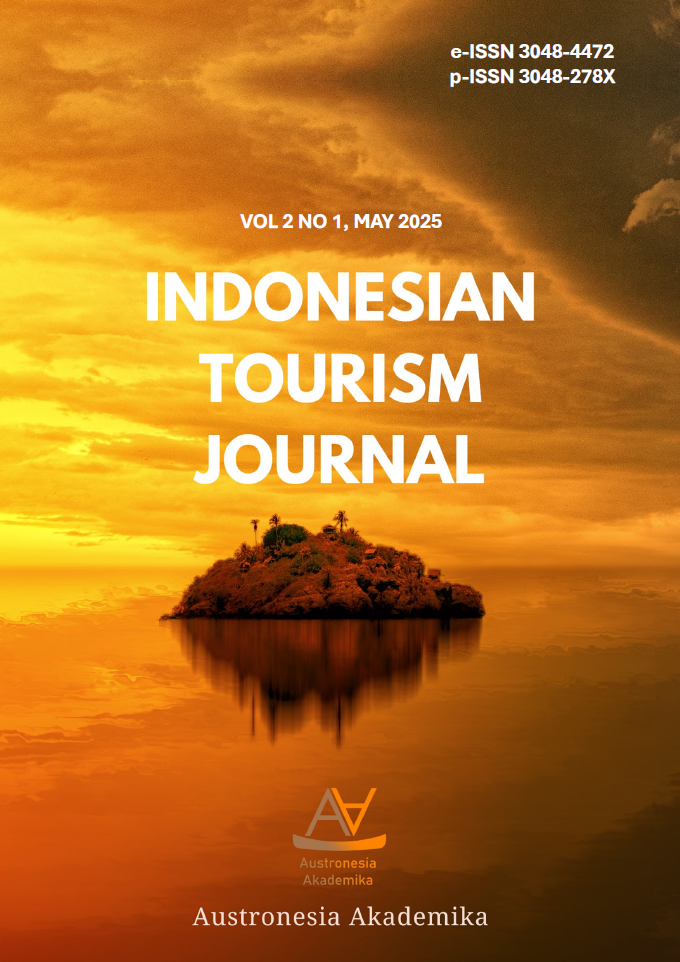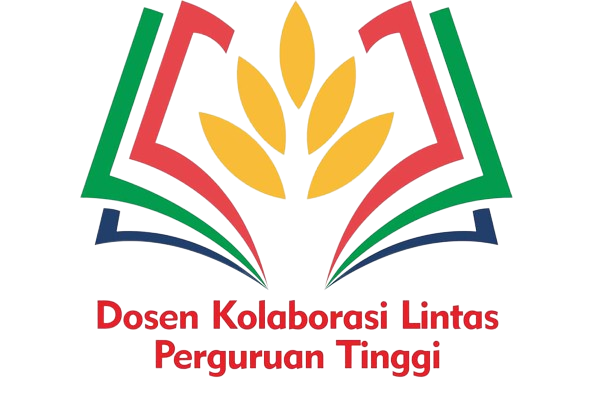Walking Tour and Culture: Fostering Cultural Collaboration Through Tourism
DOI:
https://doi.org/10.69812/itj.v2i1.103Keywords:
Walking Tour, Culture, Collaboration, TourismAbstract
Indonesia’s rich cultural diversity, encompassing over 300 ethnic groups and more than 700 local languages, presents immense potential for the development of culture-based tourism. However, this cultural wealth faces increasing threats from modernization, urbanization, and globalization, which contribute to the erosion of traditional values and local identity. One promising solution to counteract these challenges is the implementation of walking tours, which offer immersive and educational tourism experiences that foster deeper cultural appreciation while empowering local communities. This study aims to explore how walking tours can function as effective instruments for cultural preservation and community-based tourism development in Indonesia. Employing a qualitative approach through literature review, the research analyzes secondary data from academic publications, policy reports, and case studies focusing on walking tour practices in various Indonesian cities and cultural villages. The findings reveal that walking tours provide significant benefits, including the revitalization of local wisdom, economic opportunities for artisans and small businesses, and increased tourist awareness of cultural sustainability. Moreover, the role of trained local tour guides is pivotal in facilitating authentic and meaningful interactions between tourists and host communities. These tours contribute not only to visitor satisfaction but also to the strengthening of cultural identity and community resilience. In conclusion, walking tours serve as a strategic model for integrating cultural education, tourism, and community empowerment.
Downloads
References
Agarwal, S., Isha, T., Lrappa, T. V., Akaremsetty, S., & Shekhar, C. (2023). The Impact of Tourism on Local Communities: A Literature Review of Socio- Economic Factors. Journal of Harbin Engineering University, 44(8), 1851–1859.
Aji, A. F., Winata, G. I., Koto, F., Cahyawijaya, S., Romadhony, A., Mahendra, R., Kurniawan, K., Moeljadi, D., Prasojo, R. E., Baldwin, T., Lau, J. H., & Ruder, S. (2022). One Country, 700+ Languages: NLP Challenges for Underrepresented Languages and Dialects in Indonesia. Proceedings of the Annual Meeting of the Association for Computational Linguistics, 1, 7226–7249. https://doi.org/10.18653/v1/2022.acl-long.500
Adel, M. (2023). The Influence of Affiliate Marketing on Tourist Decision-Making. Journal of Association of Arab Universities for Tourism and Hospitality, 25(1), 266–277. https://doi.org/10.21608/jaauth.2024.255779.1537
Anindhita, T. A., Zielinski, S., Milanes, C. B., & Ahn, Y. J. (2024). The Protection of Natural and Cultural Landscapes through Community-Based Tourism: The Case of the Indigenous Kamoro Tribe in West Papua, Indonesia. Land, 13(8), 1237. https://doi.org/10.3390/land13081237
Anom, I. P., Mahagangga, I. G. O., Suryawan, I. B., Koesbardiati, T., & Anom, I. P. T. (2020). Case study of balinese tourism: Myth as cultural capital. Utopia y Praxis Latinoamericana, 25(Extra 6), 122–133. https://doi.org/10.5281/zenodo.3987586
Ariyaningsih, A. (2018). Strategi Pengembangan Wisata Budaya di Kawasan Pecinaan Lasem. SPECTA Journal of Technology, 2(2), 27–38. https://doi.org/10.35718/specta.v2i2.102
Atkinson, S. (2023). London Film-Location Walking Tours: Labouring at the Intersection of Text, Location and Place. In London as Screen Gateway (pp. 115–138). Taylor and Francis. https://doi.org/10.4324/9781003260899-10
Ayob, M. Z., Saman, F. M., Hussin, Z. H., & Jusoff, K. (2009). Tourists’ Satisfaction on Kilim River Mangrove Forest Ecotourism Services. International Journal of Business and Management, 4(7). https://doi.org/10.5539/IJBM.V4N7P76
Aziz, S., & Niazi, M. A. K. (2023). Understanding environmentally responsible behavior of tourists at coastal tourist destinations. Social Responsibility Journal, 19(10), 1952–1977. https://doi.org/10.1108/SRJ-10-2022-0412
Beedie, P., & Hudson, S. (2003). Emergence of mountain-based adventure tourism. Annals of Tourism Research, 30(3), 625–643. https://doi.org/10.1016/S0160-7383(03)00043-4
Bramiana, C. N., Darmawan, E., & Hasan, M. I. (2020). Stakeholder involvement in developing strategic planning for heritage buildings in Kota Lama heritage site, Semarang. IOP Conference Series: Earth and Environmental Science, 402(1), 012015. https://doi.org/10.1088/1755-1315/402/1/012015
Cohen, E. (1985). The tourist guide: The origins, structure and dynamics of a role. Annals of Tourism Research, 12(1), 5–29. https://doi.org/10.1016/0160-7383(85)90037-4
Decrop, A. (1999). Triangulation in qualitative tourism research. Tourism Management, 20(1), 157–161. https://doi.org/10.1016/S0261-5177(98)00102-2
Dencer-Brown, A. M., Shilland, R., Friess, D., Herr, D., Benson, L., Berry, N. J., Cifuentes-Jara, M., Colas, P., Damayanti, E., García, E. L., Gavaldão, M., Grimsditch, G., Hejnowicz, A. P., Howard, J., Islam, S. T., Kennedy, H., Kivugo, R. R., Lang’at, J. K. S., Lovelock, C., … Huxham, M. (2022). Integrating blue: How do we make nationally determined contributions work for both blue carbon and local coastal communities? Ambio, 51(9), 1978–1993. https://doi.org/10.1007/S13280-022-01723-1
Eksteins, M. (1999). Walking Since Daybreak: A Story of Eastern Europe, World War II, and the Heart of Our Century. Houghton Mifflin.
Falk, J. H. ., & Dierking, L. D. . (2000). Learning from Museums: Visitor Experiences and the Making of Meaning. AltaMira Press.
Gazley, A., & Watling, L. (2015). Me, My Tourist-Self, and I: The Symbolic Consumption of Travel. Journal of Travel and Tourism Marketing, 32(6), 639–655. https://doi.org/10.1080/10548408.2014.954690
Giddy, J. K., & Hoogendoorn, G. (2018). Ethical concerns around inner city walking tours. Urban Geography, 39(9), 1293–1299. https://doi.org/10.1080/02723638.2018.1446884
Haldrup, M., & Larsen, J. (2009). Tourism, performance and the everyday: Consuming the orient. In Tourism, Performance and the Everyday: Consuming the Orient. Routledge Taylor & Francis Group. https://doi.org/10.4324/9780203873939
Haq, R. A., Candra, A., & Habibi, A. (2024). Walking Tour Impacts As Cultural Tourism. Jurnal Dialektika: Jurnal Ilmu Sosial, 22(1), 93–104. https://doi.org/10.63309/dialektika.v22i1.219
Heriyanto, H., Manggong, L., & Sumarlina, E. S. N. (2019). Baduy Cultural Tourism: An Ethnolinguistic Perspective. International Journal of English Literature and Social Sciences, 4(2), 198–205. https://doi.org/10.22161/ijels.4.2.1
Idajati, H., Wahyu, D., & Prathama, A. (2024). Identification of Place Identity Characteristics in Walking Tour of Peneleh Heritage Kampong, Surabaya City, Indonesia. Media Konservasi, 29(3), 497. https://doi.org/10.29244/medkon.29.3.497
Inglehart, R., & Baker, W. E. (2000). Modernization, Cultural Change, and the Persistence of Traditional Values. American Sociological Review, 65(1), 19–51. https://doi.org/10.1177/000312240006500103
Islam, M. W., Ahmed, S., & Mahin, R. T. (2024). Motivation in community-based tourism: Linking locals to internationals in promoting community development and conservation of natural resources. Strategic Tourism Planning for Communities: Restructuring and Rebranding, 221–245. https://doi.org/10.1108/978-1-83549-015-020241018
Jamaliah, M. M., Mgonja, J. T., Alazaizeh, M. M., & Powell, R. B. (2024). How does interpretive tour guiding promote tourists’ pro-environmental behaviour? Evidence from Tanzania. Tourism Recreation Research, 49(2), 329–343. https://doi.org/10.1080/02508281.2021.1992953
Mahagangga, I. G. A. O., Anom, I. P., Suryawan, I. B., Koesbardiati, T., Wulandari, I. G. A. A., & Mutolib, A. (2021). Traditional myth and social environment Balinese tourism (A qualitative approach to sustainable development). IOP Conference Series: Earth and Environmental Science, 739(1), 012050. https://doi.org/10.1088/1755-1315/739/1/012050
Mahendra, D. (2024). The Impact of Tourism on the Preservation and Transformation of Cultural Identity in Bali, Indonesia. Studies in Social Science & Humanities, 3(6), 34–41. https://doi.org/10.56397/sssh.2024.06.05
Mallett, S. (2004). Understanding Home: A Critical Review of the Literature. The Sociological Review, 52(1), 62–89. https://doi.org/10.1111/J.1467-954X.2004.00442.X
Mustofa, B. M., & Arif, M. (2020). The Strategy of Development Jakarta Walking Tour. Journal of Indonesian Tourism and Policy Studies, 5(1), 1–3. https://doi.org/10.7454/jitps.v5i1.170
Nanlohy, A. B., Martono, E. F. E., Billah, N. B., Syafitri, R., & Subandi, M. R. (2024). Motivasi Pemandu Wisata Terkait Pay as You Wish Walking Tours di Bandung Good Guide. Journal of Event, Travel and Tour Management, 4(2), 10–22. https://doi.org/10.34013/jett.v4i2.1785
Natasari, D., Wulandari, R., Sumirah, S., & Nusa, N. D. (2022). Pemetaan Potensi Desa Dalam Rangka Menuju Desa Wisata Desa Sidoharjo Kecamatan Samigaluh Kulonprogo Yogyakarta. Jurnal Pengabdian Dan Pengembangan Masyarakat, 4(1), 25–36. https://doi.org/10.22146/jp2m.51392
Nurhadi, S. K., & Nucifera, F. (2018). Pengembangan Desa Wisata Berbasis Ekonomi Kreatif Pada Desa Wisata Blue Lagoon, Kabupaten Sleman, Yogyakarta. Prosiding Seminar Hasil Pengabdian Masyarakat, 1(1), 211–216. https://ojs.amikom.ac.id/index.php/semhasabdimas/article/view/2306
Ormond, M., & Vietti, F. (2022). Beyond multicultural ‘tolerance’: guided tours and guidebooks as transformative tools for civic learning. In Peace Through Tourism (pp. 207–223). Routledge. https://doi.org/10.4324/9781003299578-14
Parta, I. B. M. W., & Maharani, I. A. K. (2023). Cultural Tourism In Indonesia: Systematic Literature Review. Vidyottama Sanatana: International Journal of Hindu Science and Religious Studies, 7(2), 189–204. https://doi.org/10.25078/vidyottama.v7i2.2498
Roca, E., & Gomes, I. A. & R. (2015). Walking the city. Barcelona as an urban experience. Edicions Universitat Barcelona.
Sadguna, I. G. A. J., Sari, I. G. A. M. K. K., & Shishido, K. (2020). Balinese Art Studios: The Learning Process Of Art And Culture To Support Sustainable Tourism. International Journal of Applied Sciences in Tourism and Events, 4(1), 68–73. https://doi.org/10.31940/ijaste.v4i1.1782
Saputra, R. (2024). Governance Frameworks and Cultural Preservation in Indonesia: Balancing Policy and Heritage. Journal of Ethnic and Cultural Studies, 11(3), 25–50. https://www.jstor.org/stable/48793990?seq=1
Sihombing, I. H. H., Suastini, N. M., & Puja, I. B. P. (2024). Sustainable Cultural Tourism in The Era of Sustainable Development. International Journal of Sustainable Competitiveness on Tourism, 3(02), 100–115. https://doi.org/10.34013/ijscot.v3i02.1601
Snyder, H. (2019). Literature review as a research methodology: An overview and guidelines. Journal of Business Research, 104, 333–339. https://doi.org/10.1016/j.jbusres.2019.07.039
Stepputat, K. (2012). Performing Kecak: A Balinese Dance Tradition Between Daily Routine and Creative Art. In Yearbook for Traditional Music (Vol. 44). Cambridge University Press. https://doi.org/10.5921/yeartradmusi.44.0049
Sthapit, E., Björk, P., & Coudounaris, D. N. (2023). Memorable nature-based tourism experience, place attachment and tourists’ environmentally responsible behaviour. Journal of Ecotourism, 22(4), 542–565. https://doi.org/10.1080/14724049.2022.2091581
Suardana, I. W., & Sumantra, I. M. (2023). The Existence of Pure and Sacred Silver Craft Creation in Gianyar Bali. Mudra Jurnal Seni Budaya, 38(1), 39–45. https://doi.org/10.31091/mudra.v38i1.2269
Tang, Y. (2025). The Effect of Globalization on Social Sustainability in Local Communities. Journal of Lifestyle and SDGs Review, 5(5), e06592. https://doi.org/10.47172/2965-730x.sdgsreview.v5.n05.pe06592
Thomas, J. (2010). Heritage Walks as a Tool for Promoting Sustainable Historical Tourism. Atna Journal of Tourism Studies, 5(1), 40–51. https://doi.org/10.12727/ajts.5.4
Urbaite, G. (2024). The Impact of Globalization on Cultural Identity: Preservation or Erosion? Global Spectrum of Research and Humanities , 1(2), 3–13. https://doi.org/10.69760/f9g3vn77
Utami, I. G. A. C., Hendrawan, F., & Dinata, R. D. S. (2024). Sense of Place and Indigenous Wisdom: Exploring Cultural and Environmental Sustainable Practices in Ubud Palace, Bali. Proceedings of the 3rd International Conference of Art, Craft, Culture and Design (ICON-ARCCADE 2023), 7–19. https://doi.org/10.2991/978-2-38476-238-5_2
Vango, I. (2023). The Economic Benefits of Town and City Centre Living. Lichfields. https://lichfields.uk/blog/2023/december/07/the-economic-benefits-of-town-and-city-centre-living
Weiler, B., & Walker, K. (2014). Enhancing the visitor experience: Reconceptualising the tour guide’s communicative role. Journal of Hospitality and Tourism Management, 21, 90–99. https://doi.org/10.1016/j.jhtm.2014.08.001
Wisudawati, N. N. S., & Maheswari, A. A. I. A. (2018). Potential of Silver Craft Product through to Community-Based for Tourism Sustainability in Celuk Village. International Research Journal of Management, IT and Social Sciences, 5(1), 9–15. https://sloap.org/journals/index.php/irjmis/article/view/25
Yani, N. W. M. N., Puspita, N. P. L. A., & Virginiya, P. T. (2024). The Importance of Destination Image and Tourist Self-Congruity in Increasing Intention to Visit: A Case Study on Generations Y and Z at the Seaweed Tourism Destination in Nusa Penida, Bali. Jurnal Ilmiah Manajemen Dan Bisnis, 9(1), 77–91.
Zhang, Q., & Xu, H. (2020). Understanding aesthetic experiences in nature-based tourism: The important role of tourists’ literary associations. Journal of Destination Marketing and Management, 16. https://doi.org/10.1016/j.jdmm.2020.100429
Zhong, H., Zou, Y., Hao, F., Fang, Y., & Ng, W. (2025). Shaping safety: Effective signage for tourist attractions. Tourism Management, 110. https://doi.org/10.1016/j.tourman.2025.105186
Downloads
Published
How to Cite
Issue
Section
License
Copyright (c) 2025 Prita Febriani, Islakhul Muttaqin

This work is licensed under a Creative Commons Attribution-ShareAlike 4.0 International License.
You are free to:
- Share — copy and redistribute the material in any medium or format for any purpose, even commercially.
- Adapt — remix, transform, and build upon the material for any purpose, even commercially.
- The licensor cannot revoke these freedoms as long as you follow the license terms.
Under the following terms:
- Attribution — You must give appropriate credit, provide a link to the license, and indicate if changes were made . You may do so in any reasonable manner, but not in any way that suggests the licensor endorses you or your use.
- ShareAlike — If you remix, transform, or build upon the material, you must distribute your contributions under the same license as the original.
- No additional restrictions — You may not apply legal terms or technological measures that legally restrict others from doing anything the license permits.















